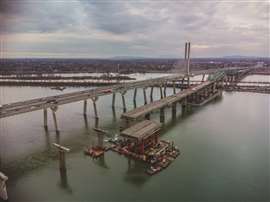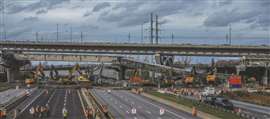Read this article in Français Deutsch Italiano Português Español
Engineering marvels: One bridge, four demolition methods
21 February 2024
Simon Hébert, Civil Works Manager and Project Director at Delsan-AIM, reveals how the company dismantled Montreal’s 3.5-km-long Champlain Bridge.
 The 3.5-km-long Champlain Bridge in Montreal, Canada, comprised four distinct structural sections, one of which was the St. Lawrence Seaway. (PHOTO: Delsan-AIM)
The 3.5-km-long Champlain Bridge in Montreal, Canada, comprised four distinct structural sections, one of which was the St. Lawrence Seaway. (PHOTO: Delsan-AIM)
Connecting the Island of Montreal to the Canadian mainland, the Champlain Bridge ran 3.5 km long and comprised a total of 50 spans.
With 30 of those spans located over the St. Lawrence River – a protected environment for wildlife and a source of drinking water for millions of people, the dismantling of the 1950s Champlain Bridge was an engineering challenge like no other.
Requiring four distinct demolition methodologies - each a marvel in their own right, and almost 40 months to complete, “it was one of the biggest professional challenges I have ever faced,” says Simon Hébert, Civil Works Manager and Project Director at Delsan-AIM.
 Simon Hébert, Civil Works Manager and Project Director at Delsan-AIM.(Photo: Delsan-AIM)
Simon Hébert, Civil Works Manager and Project Director at Delsan-AIM.(Photo: Delsan-AIM)
Planning for demolition
After a replacement bridge was opened in 2019, Jacques Cartier and Champlain Bridges Incorporated (JCCBI), contracted the Nouvel Horizon Saint-Laurent (NHSL) joint venture - for which Delsan-AIM Environmental Services was the main partner - to undertake the planning, engineering, and deconstruction of the original Champlain Bridge.
“The planning alone accounted for a quarter of the whole project time,” says Simon, and central to every aspect of the bridge’s removal, was the environment.
From the very beginning, JCCBI mandated standards that went far above and beyond those needed to achieve a Net Zero rating. The number one priority was to ensure that no harm was done the St. Lawrence River ecosystem, both during and after the works.
This meant that using explosives was not an option and that Delsan-AIM also had to ensure that no debris was allowed to fall into the river.
Taking into account the build structure and the deteriorated condition of the bridge, which since the 1990s had undergone substantial reinforcement works, Simon and his team developed a demolition plan for each distinct structural part of the bridge, dividing the project works into four sections.
 Machines were equipped with hammer and pulverizor attachments for the works. (PHOTO: Delsan-AIM)
Machines were equipped with hammer and pulverizor attachments for the works. (PHOTO: Delsan-AIM)
Mechanical dismantling
Starting on Montreal Island at the western end of the bridge, section one measured roughly 400 m in length. It comprised prestressed concrete I-beams and concrete piers that supported a post-tensioned concrete deck paved with asphalt.
Due to this part of the river being too shallow to accommodate any vessels, section one was to be removed using traditional methods. But, Delsan-AIM first had to build a 0.5-km-long temporary jetty that extended out into the St. Lawrence River, to accommodate the equipment needed for the works.
“However, by building the jetty, we would be constraining the flow of water, changing the entire hydrology of the river,” says Simon.
“The problem with that was that it would create an area of ‘dead water’ close to some key fish habitats.”
To prevent causing damage to the habitats, Delsan-AIM worked with both marine life biologists and universities to solve the problem.
“We had to do a lot of research first to make sure that we were not impacting the fish or the other animals in that microcosm.
“In the end, we built the jetty with two migration corridors and installed ten underwater cameras and sensors to count the number of fish, monitor their direction of travel and to measure their size.”
While designing and installing the jetty was the biggest challenge for this part of the demolition, Simon says: “Everybody was really impressed. For the first time in the history of the river, the university and the public were able to have real data on the fish species living in the St. Lawrence River.”
Marine demolition
The second engineering feat that Delsan-AIM had to perform was the removal of 30 bridge spans, with a total length of 1.6 km, that were situated over the St. Lawrence River.
Perhaps the most technically difficult part of the whole project from an engineering point of view, the removal of the middle section of the Champlain Bridge was carried out using a ‘lift and displacement’ methodology.
 The removal process saw each 53.7-m span cut from the bridge and its piers, before being lowered via the jacking system onto the catamaran barge. (PHOTO: Delsan-AIM)
The removal process saw each 53.7-m span cut from the bridge and its piers, before being lowered via the jacking system onto the catamaran barge. (PHOTO: Delsan-AIM)
Each of the 30 in-river spans measured 53.7 m long with a width of 24.1m. They consisted of steel trusses on reinforced concrete piers, which varied in height from 10 to 28 m tall, depending on the depth of the river - which itself ranged from 8 m to just 1.5 m deep.
The deck of each span was of a paved, post-tensioned concrete construction, incorporating seven precast, prestressed concrete girders that were tied laterally using post-tensioned, lightly reinforced concrete, transversal diaphragms.
Delsan-AIM designed and engineered the removal of each 2,000-t span in its entirety, via a single lifting operation that involved the use of four tugboats, four support barges and a 2,900-sq-m, 7,000-t capacity catamaran barge with six 800-t capacity jacking towers mounted on it.
The jacking towers were joined together by three steel box girders. A steel platform was then erected on top of the girders to provide bridging for the towers, a supporting structure for the span to be lifted, and a work area for demolition and material handling once each span was lowered.
According to Delsan-AIM, together the entire support assembly and the spans weighed a total of 4,800 t.
Simon says: “In the spring of 2021 we started assembling and mobilizing all of the systems on the barge.
“It was actually quite a challenge. Most of the equipment we needed was located in other parts of the world and, because of the Covid-19 pandemic, bringing it into Canada turned out to be a very slow process.”
Simon adds: “There were a lot of delays with procurement, assembly and mobilisation.
“In the end, we started removing the spans two and half months later than we had expected to.”
The removal process saw each 53.7-m span cut from the bridge and its piers, before being lowered via the jacking system onto the catamaran barge.
“The lifting operation for each span took three days to complete. After that, the section was dismantled on the barge - that was another three days, with the concrete evacuated to a secondary barge.
“Once a span was demolished, the remaining materials were transferred to the supporting barges and transported to a temporary wharf.
“So, every six to seven days, depending on the weather, a span was disappearing from the bridge.”
 Each 53.7-m bridge span weighed around 2,000 t. (PHOTO: Delsan-AIM)
Each 53.7-m bridge span weighed around 2,000 t. (PHOTO: Delsan-AIM)
While the catamaran barge would then move onto the next span, two other barge stations would then move in to demolish the remains of the concrete piers on which the removed span had been situated.
“To remove the piers, some of which were 20 m tall, we used our high reach excavators, which were on a barge plate,” Simon explains.
“We then mobilised a second barge to build a cofferdam around the footings, and removed the rest of the concrete pillars from the water.
“But we didn’t drain the water,” he adds. “Instead we worked underwater with a GPS system with the machine operator working from a computer screen.”
After removing all the pier material, the contractor then installed additional stone to recreate the riverbed.
Lift & Displacement
The project’s third engineering marvel, came when Delsan-AIM was tasked with removing the 2,500-t cantilevered bridge span over the St. Lawrence Seaway.
“The St. Lawrence Seaway is an international shipping channel. The main difficulty was that it could not be closed to vessels, apart from for a three-day maintenance period over the Christmas season, during which time the channel would be drained of water for inspection,” Simon explains.
“We installed six strand jacks with almost 300 steel wires and actually lowered the entire section onto a barge. It took 18 hours to lower the span 33 m onto the barge, and because the seaway had to open again, and because it was the middle of winter and there was no access, we had to push it as far as we could upriver, where we could leave it for the entire winter.”
Controlled Drop
The final challenge of this immense project was the removal of the 528-m inland, eastern section of the bridge.
While mechanical means were used to bring down the section’s four spans, the task was complicated by the presence of an eight-lane highway running directly beneath it, and by a strict 50-hour time window in which to complete the works.
 ASI Engineering carried out 3D modelling and analysis for the demoltion of the final section of the bridge. (PHOTO: Delsan-AIM)
ASI Engineering carried out 3D modelling and analysis for the demoltion of the final section of the bridge. (PHOTO: Delsan-AIM)
To ensure the spans would come down safely and without delay, ASI Engineering provided digital modelling of the planned works, which would see the first two girders on each side of the span removed first, followed by a controlled drop of the remaining girder in one operation using hydraulic shears mounted on excavators.
A fleet of 20 excavators, three high reach machines, six 40-t dump trucks, three wheeled loaders and a bulldozer brought down the final section on schedule in October of 2022.
With the last section of the Champlain Bridge finally demolished, Simon says: “We then spent the next six months removing all the temporary works, including the jetty, and then we reinstated all the land so that it looked like a bridge had never existed there at all.”
For even greater insight into the Champlain Bridge project, look out for our extended interview with Simon, coming soon.
STAY CONNECTED



Receive the information you need when you need it through our world-leading magazines, newsletters and daily briefings.
CONNECT WITH THE TEAM











